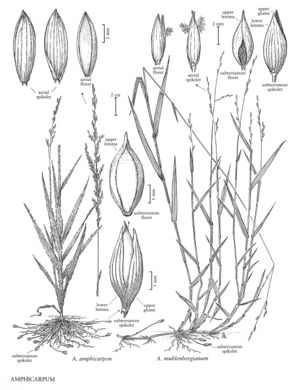Difference between revisions of "Amphicarpum muhlenbergianum"
Common names: Blue maidencane
Treatment appears in FNA Volume 25. Treatment on page 387.
FNA>Volume Importer |
FNA>Volume Importer |
||
| Line 36: | Line 36: | ||
|publication year= | |publication year= | ||
|special status= | |special status= | ||
| − | |source xml=https://jpend@bitbucket.org/aafc-mbb/fna-data-curation.git/src/ | + | |source xml=https://jpend@bitbucket.org/aafc-mbb/fna-data-curation.git/src/f6b125a955440c0872999024f038d74684f65921/coarse_grained_fna_xml/V25/V25_1098.xml |
|subfamily=Poaceae subfam. Panicoideae | |subfamily=Poaceae subfam. Panicoideae | ||
|tribe=Poaceae tribe Paniceae | |tribe=Poaceae tribe Paniceae | ||
Revision as of 19:21, 24 September 2019
Plants perennial. Culms 30-100 cm, usually decumbent, sometimes erect. Leaves evenly distributed; sheaths usually glabrous, occasionally sparsely hirsute; blades to 10(13) cm long, 5-10.5 mm wide, glabrous, margins white. Subterranean spikelets 6-9 mm, acuminate. Aerial panicles 3-20 cm; aerial spikelets 5.5-7 mm, narrowly lanceoloidal. 2n = 18.
Discussion
Amphicarpum muhlenbergianum grows in damp areas, such as dried pond bottoms, ditches, flatwoods, and swampy pinewoods of the southeastern United States.
Selected References
None.
Lower Taxa
None.
